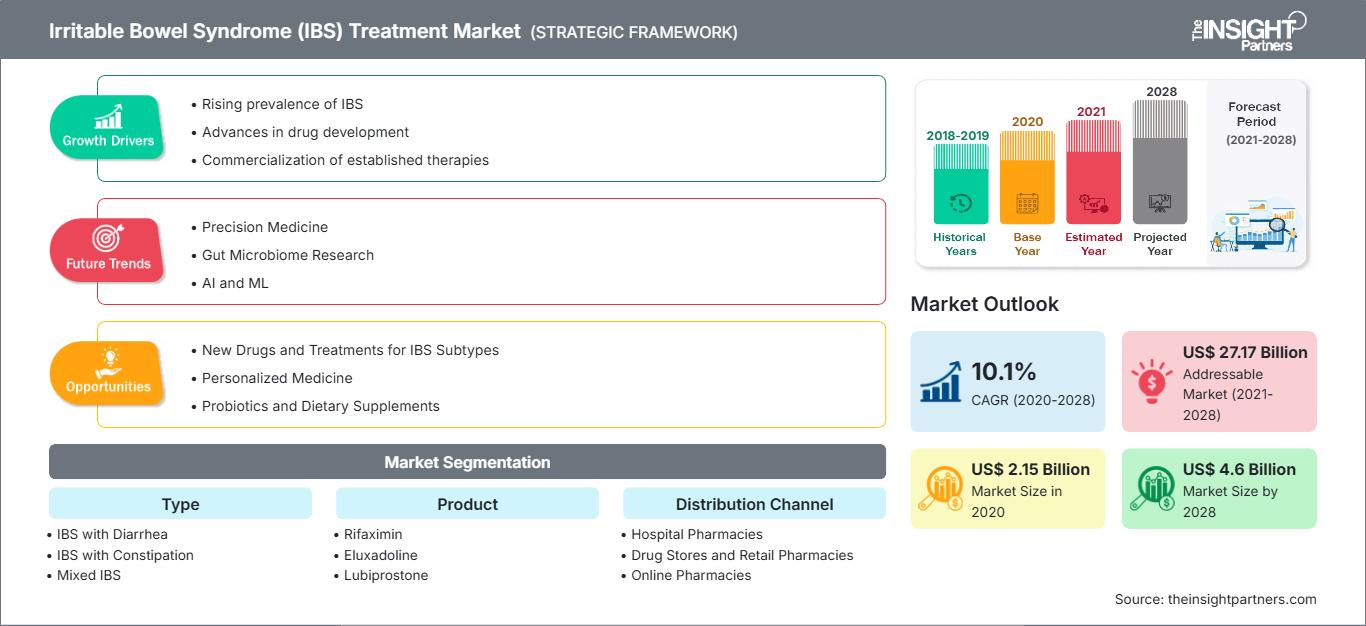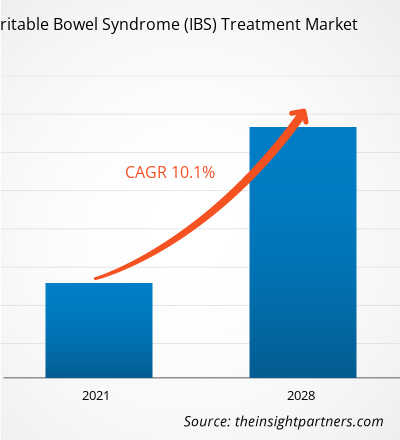Le marché du traitement du syndrome du côlon irritable (SCI) était évalué à 2 153,89 millions de dollars américains en 2020 et devrait atteindre 4 600,30 millions de dollars américains d'ici 2028 ; il devrait croître à un TCAC de 10,1 % de 2021 à 2028.
Les principaux facteurs tels que la prévalence croissante des maladies liées au syndrome du côlon irritable et l'augmentation des activités de recherche et développement stimulent la croissance du marché. Cependant, la disponibilité limitée des produits et l'inefficacité des traitements freinent la croissance du marché. Le SCI est une maladie chronique courante qui affecte l'organe abdominal, le gros intestin. Il est également connu sous le nom de côlon spastique, colite muqueuse, côlon irritable et colite spastique. Cette maladie est très différente des maladies inflammatoires chroniques de l'intestin. Elle se manifeste par des symptômes tels que des crampes, des douleurs abdominales, des ballonnements, des gaz et de la diarrhée ou de la constipation, ou les deux simultanément. Si les symptômes sont légers, ils peuvent être gérés en modifiant le stress, le mode de vie et l'alimentation. En revanche, les symptômes graves sont traités par des médicaments et des conseils.
En Asie-Pacifique, de nombreuses mesures ont été mises en œuvre pour contenir la propagation du nouveau coronavirus responsable de la COVID-19. Ces mesures ont perturbé les activités de nombreuses entreprises de divers secteurs, notamment celui de la santé. La mise en quarantaine du personnel, les ruptures de la chaîne d'approvisionnement et la baisse de la demande ont entraîné de graves complications pour les entreprises. Par ailleurs, on observe une baisse significative des soins hospitaliers et ambulatoires dans les chaînes d'hôpitaux privés. Pour soulager les systèmes de santé, de nombreuses cliniques reportent les rendez-vous non critiques. Ce scénario freine le développement du traitement du syndrome du côlon irritable (SCI).
Personnalisez ce rapport en fonction de vos besoins
Vous bénéficierez d’une personnalisation sur n’importe quel rapport - gratuitement - y compris des parties de ce rapport, ou une analyse au niveau du pays, un pack de données Excel, ainsi que de profiter d’offres exceptionnelles et de réductions pour les start-ups et les universités
Marché du traitement du syndrome du côlon irritable (SCI): Perspectives stratégiques

-
Obtenez les principales tendances clés du marché de ce rapport.Cet échantillon GRATUIT comprendra une analyse de données, allant des tendances du marché aux estimations et prévisions.
Aperçu du marché
Prévalence croissante du syndrome du côlon irritable et des affections associées
Le syndrome du côlon irritable est une affection gastro-intestinale chronique fréquemment observée, causée par des troubles du transit intestinal et des douleurs abdominales. La maladie est également connue sous le nom de côlon spastique, côlon irritable, colite muqueuse et colite spasmodique. Le syndrome du côlon irritable se manifeste par des symptômes tels que des douleurs abdominales, de la constipation, de la diarrhée et des crampes. Les systèmes de santé de toutes les régions constatent une croissance considérable de l'incidence du syndrome du côlon irritable. Des données publiées par la Fondation internationale pour les troubles gastro-intestinaux indiquent que parmi tous les patients atteints du SCI, environ 40 % souffrent d'un SCI léger, environ 35 % d'un SCI modéré et environ 25 % souffrent d'un SCI sévère. De nombreuses personnes ne reconnaissent pas les symptômes du SCI.
Certains facteurs tels que les allergies alimentaires, les stades évolutifs de la gastro-entérite, les mouvements sporadiques du côlon, la composition anormale de la sérotonine dans le côlon et la maladie cœliaque légère font partie des facteurs de risque pouvant causer le SCI. Ces facteurs devraient accélérer le taux de prévalence du SCI dans le monde. Par exemple, selon une étude publiée sur NCBI en 2018, le SCI toucherait environ 10 à 16 % de la population américaine chaque année. Une prévalence aussi stupéfiante du SCI est susceptible de stimuler le marché du traitement du syndrome du côlon irritable (SCI) au cours de la période de prévision.
Informations basées sur le type
En fonction du type, le marché du traitement du syndrome du côlon irritable (SCI) est segmenté en SCI mixte (SCI-M), SCI avec diarrhée (SCI-D) et SCI avec constipation (SCI-C). En 2020, le segment du SCI mixte (SCI-M) détenait la plus grande part de marché. Français De plus, ce même segment devrait enregistrer le TCAC le plus élevé au cours de la période de prévision. La prévalence croissante du SCI chez les femmes et les hommes devrait stimuler la demande de médicaments capables de traiter les symptômes combinés de constipation et de diarrhée. La prévalence du SCI est plus élevée chez la population vieillissante. Par conséquent, la demande de médicaments pour traiter le SCI mixte devrait augmenter considérablement au cours de la période de prévision.
Informations basées sur les produits
Sur la base des produits, le marché du traitement du syndrome du côlon irritable (SCI) est segmenté en rifaximine, eluxadoline, lubiprostone, linaclotide, etc. Le segment du linaclotide détenait la plus grande part de marché en 2020. De plus, ce même segment devrait enregistrer le TCAC le plus élevé du marché au cours de la période de prévision. La croissance du marché pour ce segment est attribuée à des facteurs tels que l'augmentation de la production de versions génériques du linaclotide et la consolidation croissante du marché pour le développement et la commercialisation du linaclotide dans le traitement du syndrome du côlon irritable (SCI).
Informations basées sur les canaux de distribution
Selon les canaux de distribution, le marché du traitement du syndrome du côlon irritable (SCI) est segmenté en pharmacies hospitalières, parapharmacies et pharmacies de détail, ainsi qu'en pharmacies en ligne. En 2020, le segment des pharmacies hospitalières détenait la plus grande part de marché. Cependant, le segment des parapharmacies et des pharmacies de détail devrait enregistrer le TCAC le plus élevé au cours de la période de prévision.
Les entreprises opérant sur le marché du traitement du syndrome du côlon irritable (SCI) adoptent une stratégie d'innovation produit pour répondre à l'évolution de la demande des clients à travers le monde, ce qui leur permet également de maintenir leur marque sur le marché mondial.
Aperçu régional du marché du traitement du syndrome du côlon irritable (SCI)
Les tendances régionales et les facteurs influençant le marché du traitement du syndrome du côlon irritable (SCI) tout au long de la période de prévision ont été analysés en détail par les analystes de The Insight Partners. Cette section aborde également les segments de marché et la géographie du traitement du syndrome du côlon irritable (SCI) en Amérique du Nord, en Europe, en Asie-Pacifique, au Moyen-Orient et en Afrique, ainsi qu'en Amérique du Sud et en Amérique centrale.
Portée du rapport sur le marché du traitement du syndrome du côlon irritable (SCI)
| Attribut de rapport | Détails |
|---|---|
| Taille du marché en 2020 | US$ 2.15 Billion |
| Taille du marché par 2028 | US$ 4.6 Billion |
| TCAC mondial (2020 - 2028) | 10.1% |
| Données historiques | 2018-2019 |
| Période de prévision | 2021-2028 |
| Segments couverts |
By Type
|
| Régions et pays couverts |
Amérique du Nord
|
| Leaders du marché et profils d'entreprises clés |
|
Densité des acteurs du marché du traitement du syndrome du côlon irritable (SCI) : comprendre son impact sur la dynamique commerciale
Le marché du traitement du syndrome du côlon irritable (SCI) connaît une croissance rapide, portée par une demande croissante des utilisateurs finaux, due à des facteurs tels que l'évolution des préférences des consommateurs, les avancées technologiques et une meilleure connaissance des avantages du produit. Face à cette demande croissante, les entreprises élargissent leur offre, innovent pour répondre aux besoins des consommateurs et capitalisent sur les nouvelles tendances, ce qui alimente la croissance du marché.

- Obtenez le Marché du traitement du syndrome du côlon irritable (SCI) Aperçu des principaux acteurs clés
- Analyse historique (2 ans), année de base, prévision (7 ans) avec TCAC
- Analyse PEST et SWOT
- Taille du marché Valeur / Volume - Mondial, Régional, Pays
- Industrie et paysage concurrentiel
- Ensemble de données Excel
Rapports récents
Témoignages
Raison d'acheter
- Prise de décision éclairée
- Compréhension de la dynamique du marché
- Analyse concurrentielle
- Connaissances clients
- Prévisions de marché
- Atténuation des risques
- Planification stratégique
- Justification des investissements
- Identification des marchés émergents
- Amélioration des stratégies marketing
- Amélioration de l'efficacité opérationnelle
- Alignement sur les tendances réglementaires






















 Obtenez un échantillon gratuit pour - Marché du traitement du syndrome du côlon irritable (SCI)
Obtenez un échantillon gratuit pour - Marché du traitement du syndrome du côlon irritable (SCI)